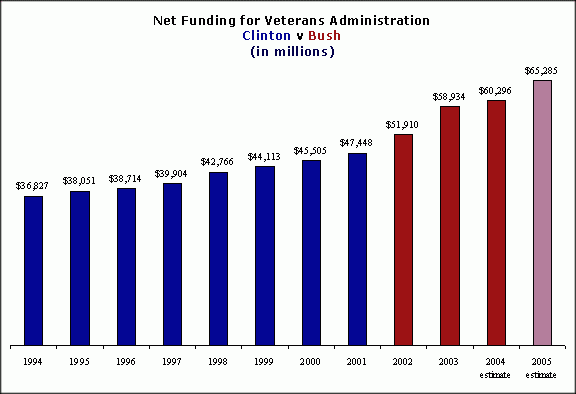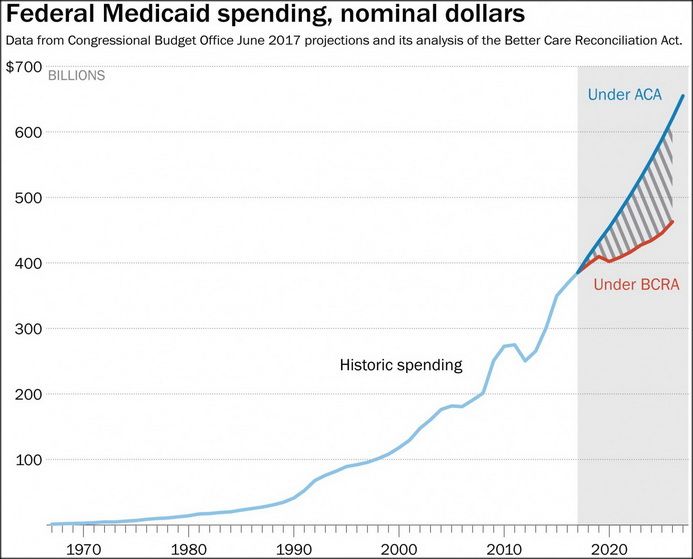What Medicaid Is Not!
Medicaid was created in 1965 as a safety net for the poor. But Obamacare distorted it, edging the U.S. closer to a Medicaid-for-all or single-payer system. Swelling the Medicaid rolls — not making private insurance affordable — is the main way Obamacare dealt with the uninsured.
Almost 75 million people are now enrolled, 20 million more than in Medicare, the program for the elderly. If the repeal bill doesn’t pass, Medicaid enrollment will soar to 86 million by 2026, according to a Congressional Budget Office analysis released Monday.
Who’s picking up the tab for this vast Medicaid expansion? You. Worse, you pay twice — once as a taxpayer, and then again as an insurance consumer. Families with private insurance pay $1,500 to $2,000 or more in added premiums yearly already to keep Medicaid afloat. The more Medicaid expands, the higher their premiums will go. That’s because Medicaid shortchanges hospitals and doctors, paying less than the actual cost of care. They make up for it by shifting the costs onto privately insured patients. Ouch.
That cost shifting only works until Medicaid enrollment grows too large. The Mayo Clinic warned three months ago that Medicaid enrollment has reached the tipping point. The renowned clinic announced it will have to turn away some Medicaid patients or put them at the back of the line, behind patients with commercial insurance.
Years earlier, when Obamacare was still being debated in Congress, the dean and CEO of Johns Hopkins Medicine, Dr. Edward Miller, issued a similar warning: Allowing a vast expansion of Medicaid could have “catastrophic effects” at places like Hopkins.
His dire prediction came true. Obamacare loosened Medicaid eligibility rules and urged states to enroll as many people as possible, with Uncle Sam paying 100 percent of the tab until 2016 and 90 percent or more thereafter.
Medicaid enrollment spiked in many states, including New York, where it skyrocketed up by a third to 6.3 million. Blame the incentive to rake in federal dollars.
And waste money. Roughly 10.5 percent of Medicaid payments are in error. Any company with that record would be out of business….
But we already know that insurance companies were pulling out en-mass because of the strain the ACA caused. For the record, I am FIRMLY AGAINST any federal spending on medical care… I am in agreement with the father of the Constitution that “charity is no part of the legislative duty of the [federal] government.”
In fact, quite the contrary. The Senate bill will codify and make permanent the Medicaid expansion, and will, in fact, have the federal government pay the lion’s share of the cost. Remember, ObamaCare created a new category of eligibility. Working age, able-bodied adults with no dependents for the first time became eligible for Medicaid if their income is below 138 percent of the poverty level. [editor’s note: which is why it (the ACA) should be repealed completely, not replaced!]
The Left’s rhetoric is legend, here you can see it in action regarding Medicaid:
…It doesn’t help that news reports criminally misrepresent the CBO score, stating flatly that 22 million people will “lose” insurance under the plan. Or when ostensibly neutral news articles announce that Medicaid will be “slashed” or “gutted” under the Senate bill.
In fact, the bill merely slows Medicaid’s rate of growth. Under the Senate plan, federal Medicaid spending would still increase $73 billion by 2026 — and while that’s well below the scheduled amount of spending under Obamacare, conservatives maintain the current law’s trajectory is unsustainable…
This remind’s me of when the Democrats said Bush was cutting benefits to veteran’s, but in fact he was raising them mroe than during Clinton’s tenure:

Only in government does slowing the growth of spending mean “cuts”
FORBES deals with a couple of the lies/myths by the Left in regard to “cuts.”
False claim: Growing costs are the main problem & per capita cap funding will not be enough
Reality: Enrollment growth is driving spending increases and per capita caps are a good first step towards reform
When the Congressional Budget Office (CBO) scored these bills, the projected savings from changes in Medicaid were almost entirely related to Medicaid enrollment changes– not capping the program. In fact, analysis by my colleague Jonathan Ingram at the Foundation for Government Accountability has shown that, historically, almost all states would not have exceeded the caps set in the House bill. Just 0.4 percent of spending would have exceeded the cap.
Actually, the caps are projected to grow at a higher rate than projected spending for seniors and the disabled. (4.8% projected for 2019 and beyond vs. 4.6%)
Altogether, if the caps had been in place starting in 2000, actual spending growth would have remained lower than the targets set by BCRA.
But here is the line of cutting spending overall… remember, not by capping the program:
But in reality, the benefits of Medicaid is lacking, as any government program:
- Medicaid is a program that is rife with inefficiency. A 2015 study found that recipients derived only 20 to 40 cents of benefit for every dollar governments spend on it. Researchers have struggled to find any positive effects Medicaid has on beneficiaries’ physical health. — Ramesh Ponnuru
- “If enacted, the President’s budget would be a major down payment on federal entitlement reform. It cannot be overemphasized that analysts and economists, often of very different political persuasions, are united in their conviction that policymakers must take decisive steps to slow the growth of federal entitlement spending. By putting Medicaid on a budget—either through a fixed allotment to the states in the form of a block grant or a per capita cap—the Trump budget would give state officials much needed flexibility in managing the program and better target services to the poorest and most vulnerable of our citizens.” — Robert Moffit
- In September, the Department of Health and Human Services sent out a warning that improper payments under Medicaid have become so common that they will account this year for almost 12 percent of total Medicaid spending — just shy of $140 billion. (Total improper payments across federal programs will come to about $139 billion this year, according to estimates that have proved too generous in the past, and almost all of that is Medicaid-driven.) That rate has doubled in only a few years, driven mostly by the so-called Affordable Care Act’s liberalization of Medicaid-eligibility rules. — Kevin D. Williamson
And there is waste in other areas as well. CNS-NEWS has an article on how many children are born on Medicare…
New Mexico led all states with 72 percent of the babies born there in 2015 having their births covered by Medicaid.
Arkansas ranked second with 67 percent; Louisiana ranked third with 65 percent; and three states—Mississippi, Nevada and Wisconsin—tied for fourth place with 64 percent of babies born there covered by Medicaid.
New Hampshire earned the distinction of having the smallest percentage of babies born on Medicaid. In that state, Medicaid paid for the births of only 27 percent of the babies born in 2015.

Virginia and Utah tied for the next to last position, with 31 percent of the babies born on Medicaid.
However, according to KFF, some of the nation’s most populous states shared the distinction of having 50 percent or more of the babies born there born on Medicaid.
In California, Florida and Illinois, for example, 50 percent of all babies were born on Medicaid in the latest year on record.
In New York, 51 percent of the babies were born on Medicaid.
In Ohio, 52 percent of babies were born on Medicaid.
The Kaiser Family Foundation gathered its data on the number of babies born on Medicaid in each state by surveying the state Medicaid directors.
“Medicaid directors were asked to provide the most recent available data on the share of all births in their states that were financed by Medicaid,” said a KFF report.
“About half of the states were able to provide data for calendar 2015 or fiscal year 2015,” said KFF. “Other states generally provided data from 2013 or 2014. On average, states reported that Medicaid pays for just over 47 percent of all births.”
“Eight states (Arkansas, Louisiana, Mississippi, Nevada, New Mexico, Oklahoma, South Carolina and West Virginia) reported that Medicaid pays for 60 percent or more of all births in their state,” reported KFF.
[…..]
By 2010, according this report, the percentage of births in the United States covered by Medicaid had risen to 47.75 percent—or 1,805,151 out of 3,780,519 total births.
Another report, published by the Centers for Disease Control and Preventionlater in December 2013, looked at the form of payment for births in the 33 states and the District of Columbia that as of 2010 had adopted the 2003 version of “U.S. Standard Certificate for Live Birth.” This certificate specifically asks the mother to say which of four categories the payment for her child’s birth falls into: private insurance, Medicaid, self-pay, or other.
This data, according to the CDC, covered all 2010 births in the 33 states and the District of Columbia, which accounted for 76 percent of all births in the nation in that year. According to the CDC, this data revealed that 44.9 percent of the babies born in these jurisdictions in 2010 were born on Medicaid.
In this 2010 CDC data for 33 states, New Mexico also led with the highest percentage of births on Medicaid—with 57.5 percent of all babies born there that year having their births covered by Medicaid.
When I see this it is the same thing as the Pentagon buying a toilet seat for $640, I expect everyone to be besides themselves with that. The same thing I expect with the above list. The problem is that Democrats are pinning their single-payer hopes on Medicaid.
